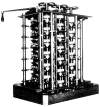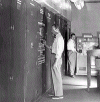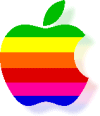1642

Blaise Pascal, a French philosopher and mathematician, invented the Pascaline. This was a mechanical machine that
was supposed to perform addition. However, Pascal did not get the machine to work properly due to manufacturing problems.
|
 |
Late 1600s

Gottfried Wilhelm von Leibniz, a famous mathematician, designed the Stepped Reckoner, a device capable of adding, subtracting, multiplying, dividing,
and calculating the square root of numbers. However, the device tended to break down.
|
 |
1833

Charles Babbage designed the Analytical Engine. The device was intended to perform calculations based on a program stored on punch cards.
|
 |
Late 1800s

Herman Hollerith invented a tabulating machine that could perform calculations by using electricity rather than mechanical gears.
This device was used by the U.S. Census Bureau for the Census of 1890.
|
 |
Late 1930s, Early 1940s

Alan Turing presented an idea of a "universal machine." His idea suggested that a computer should be able to perform different things by changing its program,
rather than its electronic components.
|
 |
1939-1942

John Atanasoff built the first electronic computer at Iowa State University. This computer, called the Atanasoff-Berry Computer
(ABC), used vacuum tubes and stored information by electronically burning holes into sheets of paper. The ABC used the binary
system of 1's and 0's that is still used in computers today.
|
 |
1943-1946

John Mauchly and J. Presper Eckert constructed the Electronic Numerical Integration and Calculator (ENIAC) at the University of
Pennsylvania. It occupied 1500 square feet and weighed 30 tons.
|
 |
1944

Howard Aiken leads IBM and Harvard University to complete the Mark I. The Mark I used mechanical telephone relay switches for
storing information, and received data via punch cards. However, the Mark I was more of a calculator than a computer because
it could not make decisions about the data it accepted.
|
 |
1945

John von Neumann created the idea of a CPU (central processing unit). Later, Neumann, along with John Mauchly and J. Presper Eckert,
constructed the EDVAC (Electronic Discrete Variable Automatic Computer) and the EDSAC (Electronic Delay Storage Automatic Computer).
These machines interpreted instructions by being fed paper tape that contained machine language, which consists of ones and zeros
that represent a switch that is on or off, respectively.
|
 |
1947

William Shockley, John Bardeen, and Walter Brittain of Bell Laboratories invented the first transistor. Transistors replaced the
original vacuum tubes of computers. They made computers smaller, less expensive, and up to 10 times faster. Shockley, Bardeen,
and Brittain later won the Nobel Prize in physics for their invention.
|
 |
1951

The U.S. Census Bureau bought the UNIVAC (UNIVersal Automatic Computer). This computer was the third computer to use the stored
program concept, and was built by Mauchly and Eckert.
|
 |
1957

John Backus and a team of researches developed FORTRAN (FORmula TRANslator), a high-level programming language that had English-like commands.
|
 |
1959

COBOL (COmmon Business Oriented Language) was developed by the Department of Defense to offer a common language to be used on all computers.
|
 |
Early 1960s

IBM came out with the Model 650. It was smaller, but could still meet the needs of businesses and government agencies, and it became
quite popular despite its high price.
|
 |
1960s

BASIC (Beginner's All-Purpose Symbolic Instruction Code) was designed by John Kemeny and Thomas Kurtz at Dartmouth University.
|
 |
1961

Jack Kilby and Robert Noyce (working independently) developed the integrated circuit, also known as a chip.
|
 |
1964

IBM introduced the Model 360. It was one of the first computers to use integrated circuits. The reduced size and price made the
360 affordable for hospitals and universities.
|
 |
1970

Marcian Hoff, an engineer at Intel Corporation, created the microprocessor. The microprocessor is the entire CPU on one single chip,
and made it possible to build microcomputers that could fit on a desktop.
|
 |
1975

The first microcomputer, the Altair, was built.
|
 |
1976

Steve Wozniak and Steven Jobs created the first Apple Computer.
|
 |
1981

IBM introduced the IBM-PC. The computer was very successful because of its ability to handle word processing, spreadsheet, and
accounting software.
|
 |